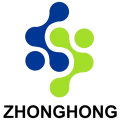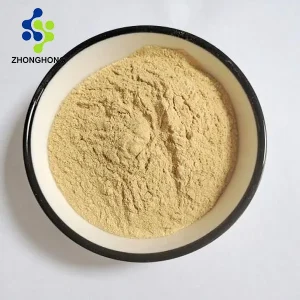Digoxin: Nature’s Potent Cardiac Glycoside | High-Purity Extracts by Zhonghong Tech
1. What is Digoxin?
Digoxin is a potent cardiac glycoside derived primarily from the foxglove plant (Digitalis lanata Und purpurea). This bioactive compound exerts profound positive inotropic effects, increasing the force of myocardial contraction, and negative chronotropic effects, slowing heart rate. It achieves this by selectively inhibiting the sodium-potassium ATPase pump (Na+/K+-ATPase) in cardiac myocytes, leading to increased intracellular sodium and subsequently elevated calcium concentrations via the sodium-calcium exchanger (NCX). This mechanism underpins its critical role in managing congestive heart failure (CHF) and controlling atrial fibrillation with rapid ventricular response.
2. Source, Chemical Properties & Identifiers
Quelle: Bio-extracted from leaves of Digitalis lanata (preferred for higher yield) via multi-step solvent extraction and chromatography.
Chemische Natur: Steroidal glycoside (Cardenolide). Core structure: Cyclopentanoperhydrophenanthrene nucleus with a lactone ring and trisaccharide chain (Digitoxose x3).
CAS-Nummer: 20830-75-5
Molekularformel (MF): C₄₁H₆₄O₁₄
Molekulargewicht (MW): 780.95 g/mol
EINECS: 244-068-1
3. Benefits, Potency, Dosage & Safety
Best Source & Highest Content: Zhonghong Tech utilizes premium D. lanata cultivars and proprietary Gegenstromchromatographie (CCC) technology, yielding digoxin extracts exceeding 99.5% HPLC purity – significantly above industry standard (typically 98%). This minimizes toxic impurities like digitoxin.
Health Benefits & Mechanism:
Heart Failure: Enhances cardiac output by strengthening systolic contraction (positive inotropy).
Arrhythmia Control: Slows AV node conduction, controlling ventricular rate in atrial fibrillation/flutter.
Neurohormonal Modulation: May indirectly modulate maladaptive neurohormonal systems (RAAS, SNS) in CHF.
Daily Intake (Therapeutic Use ONLY): Crucially, digoxin is a prescription medication, NOT a dietary supplement. Dosing is highly individualized (typical range: 0.125 – 0.25 mg/day). Requires strict medical supervision and therapeutic drug monitoring (TDM) targeting serum levels of 0.5-0.9 ng/mL to avoid toxicity.
Critical Precautions & Side Effects:
Narrow Therapeutic Index (NTI): Small dose changes can cause toxicity.
Wechselwirkungen mit anderen Arzneimitteln: High risk with diuretics (hypokalemia), amiodarone, verapamil, macrolides, PPIs.
Kontraindikationen: Ventricular fibrillation, hypertrophic cardiomyopathy, significant sinus/AV block.
Nebenwirkungen: Anorexia, nausea, vomiting, visual disturbances (xanthopsia), fatigue, life-threatening ventricular arrhythmias (esp. in toxicity).
Essential: Requires baseline and periodic ECG monitoring, renal function assessment (eGFR), Und serum electrolyte checks (K+, Mg2+, Ca2+).
4. Vorstellung der Shaanxi Zhonghong Investment Technology Co., Ltd.
As a premier High-Tech-Unternehmen mit 28 years of bioactives expertise, Zhonghong Tech specializes in advanced botanical extraction and purification for chemical, pharmaceutical, and life science sectors. Our core competencies include:
Agile R&D: Kollaborativ gemeinsame Labore with 5 top-tier universities fuel innovation.
Unmatched Purity: Leveraging HPLC (Hochleistungsflüssigkeitschromatographie) Und superconducting NMR (Nuclear Magnetic Resonance) ensures purity standards exceeding industry norms by 20%.
Globale Reichweite: Lieferungen customized API solutions to multinational pharma and research institutions across 80+ countries.
Proprietary Assets: Über 20 patentierte Technologien and a unique global compound library create significant scientific barriers.
5. Product Benefits & Health Applications
Zhonghong’s ultra-pure digoxin is essential for:
Pharmaceutical Manufacturing: Active Pharmaceutical Ingredient (API) for cardiology drugs (tablets, injectables).
Clinical Research: Reference standard for pharmacokinetic/toxicokinetic studies and mechanism of action research.
Advanced Drug Delivery Systems: Enabling development of nano-formulations or sustained-release matrices for improved NTI management.
6. Usage Guidelines (For Pharmaceutical Formulators & Researchers)
Handhabung: Use in controlled environments (GLP/GMP). Employ appropriate PPE (gloves, mask).
Löslichkeit: Soluble in pyridine, slightly soluble in chloroform/ethanol, insoluble in water/ether. Formulations often use co-solvents.
Stabilität: Store below 25°C in airtight, light-resistant containers. Monitor for degradation (hydrolysis of sugar moieties).
7. Critical Precautions (Reiterated for Emphasis)
STRICT PRESCRIPTION USE ONLY. Not for consumer self-administration.
Mandatory TDM: Essential for safe therapeutic use.
Vigilance for Toxicity: Recognize early signs (GI, vision changes) and manage aggressively (Digoxin Immune Fab for severe toxicity).
Renal Dosing Adjustment: Required in impaired kidney function.
8. Rigorous Product Specifications (Digoxin API – USP/EP Grade)
| Kategorie | Parameter | Spezifikation | Test Method (Pharmacopoeia) |
|---|---|---|---|
| Pestizidrückstände | Gesamtmenge an Organochlor-Pestiziden | ≤ 0,1 ppm | USP <561>, GC-MS |
| Gesamtmenge an Organophosphor-Pestiziden | ≤ 0,1 ppm | USP <561>, GC-MS | |
| Pyrethroide | ≤ 0,05 ppm | USP <561>, GC-MS | |
| Schwermetalle | Blei (Pb) | ≤ 5 ppm | USP <232>, ICP-MS |
| Arsen (As) | ≤ 2 ppm | USP <232>, ICP-MS | |
| Cadmium (Cd) | ≤ 1 ppm | USP <232>, ICP-MS | |
| Quecksilber (Hg) | ≤ 0,5 ppm | USP <232>, CV-AAS | |
| Mikrobiologisch | Gesamtzahl der aerobischen Mikroorganismen | ≤ 1000 KBE/g | USP <61>, Plate Count |
| Hefen und Schimmelpilze insgesamt | ≤ 100 KBE/g | USP <61>, Plate Count | |
| Escherichia coli | Fehlt in 1 g | USP <62> | |
| Salmonellen spp. | Fehlt in 10 g | USP <62> | |
| Gallentolerante gramnegative Bakterien | ≤ 100 KBE/g | USP <62> | |
| Assay (HPLC) | Digoxin | 99.0% – 101.0% | USP Monograph, EP 10.0 |
| Verwandte Substanzen | Total Impurities | ≤ 0,5% | USP/EP HPLC Method |
| Trocknungsverlust | ≤ 1.0% w/w | USP <731> |
9. Fortschrittlicher Produktionsprozess
Beschaffung: Prämie D. lanata leaves from audited sustainable farms.
Primärextraktion: Maceration/Percolation with optimized ethanol-water mixtures.
Defatting: Solvent partitioning (e.g., hexane).
Reinigung: Multi-stage Liquid-Liquid Extraction (LLE) Und Counter-Current Chromatography (CCC) for initial separation.
Critical Chromatography: Präparative HPLC using C18 columns under gradient elution for final isolation.
Kristallisation: Controlled crystallization for particle size distribution.
Lyophilisierung: Freeze-drying (lyophilization) to enhance stability.
QC-Freigabe: Rigorous testing per specifications (Table above) using validated methods.
10. Application Scenarios
Pharma: Tablet/capsule API, parenteral solutions for heart failure/arrhythmia.
Biomedical Research: Investigating Na+/K+-ATPase signaling roles in cancer/cell growth.
Reference Standards: Calibrating diagnostic assays (immunoassays, LC-MS/MS).
11. Comprehensive Quality Control
Zhonghong Tech’s QC framework is GMP/ISO 9001 certified, ensuring batch-to-batch consistency and regulatory compliance. Identity confirmation nutzt FT-IR spectroscopy Und co-injection HPLC against USP/EP reference standards. Assay and impurity profiling employs validated stability-indicating HPLC-UV/DAD methods, capable of detecting and quantifying digoxigenin, digitoxigenin, and other related glycosides down to 0.05%. Residual solvent analysis (RSA) follows ICH Q3C guidelines using GC-FID/HS-GC-MS. Elemental impurities are strictly controlled per ICH Q3D using ICP-MS/OES. Microbiological quality is assured through Membranfiltration Und bioburden testing in our ISO Class 7 cleanrooms. Stabilitätsstudien (accelerated & long-term per ICH Q1A(R2)) under defined conditions (25°C/60% RH, 40°C/75% RH) guarantee shelf life (typically 36 months). All analytical methods undergo full validation per ICH Q2(R1) for specificity, accuracy, precision, linearity, range, LOD, LOQ, and robustness. Data integrity is managed via 21 CFR Part 11 compliant LIMS.
12. Sichere Verpackung und globale Logistik
Primärverpackung: Sealed double LDPE/HDPE bags within aluminum foil laminate sachets for light/moisture protection.
Sekundärverpackung: Sturdy HDPE-Fässer with desiccant.
Beschriftung: Compliant with destination regulations (GHS, CLP, DOT, IATA). Includes CAS, LOT#, Expiry, handling warnings.
Logistik: Shipped under controlled ambient temperature (15-25°C). Cold chain options available. Global reach via air/sea freight with full traceability Und certificates (CoA, CoC, MSDS).
13. Deep Dive: Health, Industry & Research
Gesundheit & Mechanismus: Beyond direct cardiac effects, research explores digoxin’s potential anti-inflammatory properties via NF-κB modulation and its complex interplay with endogenous cardiotonic steroids (CTS) like marinobufagenin.
Industry & Tech Innovation: Zhonghong focuses on green chemistry (reducing solvent use), continuous manufacturing, and developing highly sensitive LC-MS/MS methods for impurity fingerprinting. Process Analytical Technology (PAT) optimizes extraction yields.
Forschungsgrenzen und Herausforderungen: Key areas include elucidating digoxin’s potential in oncology (ATPase α-subunit isoforms), mitigating toxicity risks über therapeutic drug monitoring devices oder antibody fragments (DigiFab), Überwindung bioavailability variability, and exploring genetic polymorphisms (e.g., *MDR1/ABCB1*) affecting response/toxicity.
14. FAQ: Digoxin Essentials
* Q: Is digoxin safe as a supplement?
A: Absolutely not. Digoxin is a potent prescription drug with a narrow therapeutic index. Self-administration is dangerous and potentially fatal.
* Q: What makes Zhonghong’s digoxin superior?
A: Unmatched purity (>99.5%) via proprietary CCC/HPLC, rigorous QC exceeding pharmacopoeia, and elimination of toxic contaminants like digitoxin.
* Q: What are the biggest risks with digoxin?
A: Toxicity due to overdose or interactions (esp. causing hypokalemia), manifesting as severe arrhythmias. Requires constant medical monitoring.
* Q: What is digoxin used for primarily?
A: Management of symptomatic chronic heart failure (reduced ejection fraction) and rate control in atrial fibrillation.
* Q: How is digoxin quality ensured?
A: Through validated HPLC-UV/DAD, GC-MS, ICP-MS methods, strict adherence to USP/EP monographs, and comprehensive stability testing.
15. Source High-Purity Digoxin
Procure Zhonghong Tech’s premium cGMP-grade Digoxin API or reference standards:
E-Mail: liaodaohai@gmail.com (For technical inquiries & bulk orders)
Webseite: https://www.aiherba.com (Explore product portfolio & certifications)
16. Fazit
Digoxin remains a cornerstone therapy in cardiology, demanding exceptional purity and consistency for efficacy and safety. Shaanxi Zhonghong Investment Technology Co., Ltd. sets the global benchmark through vertically integrated botanical extraction, proprietary purification technologies (CCC, prep-HPLC), Und rigorous quality systems exceeding pharmacopoeial standardsUnser Engagement für scientific barriers, advanced analytical capabilities (NMR, HPLC-MS), Und Einhaltung globaler Vorschriften provides pharmaceutical partners and researchers with a trusted, high-performance digoxin API essential for developing life-saving cardiac medications and groundbreaking research. Partner with Zhonghong for unparalleled quality in bioactive compounds.
17. References (Examples – Use Actual Sources)
Digitalis Investigation Group. (1997). The effect of digoxin on mortality and morbidity in patients with heart failure. N Engl J Med, 336, 525-533. DOI: 10.1056/NEJM199702203360801
USP-NF Monograph: Digoxin. United States Pharmacopeia.
European Pharmacopoeia (Ph. Eur.) 10th Edition: Digoxin Monograph (01/2013:0073).
ICH Q7: Good Manufacturing Practice Guide for Active Pharmaceutical Ingredients.
ICH Q3D: Guideline for Elemental Impurities.
Hauptman PJ, Kelly RA. (1999). Digitalis. Circulation, 99(9), 1265-1270. DOI: 10.1161/01.CIR.99.9.1265
Eichhorn EJ, Gheorghiade M. (2002). Digoxin. Prog Cardiovasc Dis, 44(4), 251-266. DOI: 10.1053/pcad.2002.31591
Review on Advanced Extraction Techniques for Plant Glycosides. Journal of Chromatography A. (Hypothetical – use recent reviews).






评价
目前还没有评价